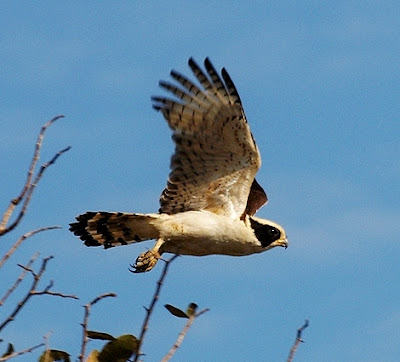Herpetotheres cachinnans
 |
| Photo by Joaquim Mello (Flickr) |
Common name:
laughing falcon (en); acauã (pt); macagua rieur (fr); halcón reidor (es); lachfalke (de)
Taxonomy:
Order Falconiformes
Family Falconidae
Range:
This species is found from Mexico, throughout Central America and into South America as far south as Peru, Bolivia, Paraguay, southern Brazil and marginally into northern Argentina.
Size:
These birds are 46-56 cm long and have a wingspan of 79-94 cm. The females tend to be larger than the males, weighing 600-800 g while the males weigh 410-680 g.
Habitat:
The laughing falcon is mostly found in along the edges of forested areas, including both moist and dry tropical forests, as well as swamp forests and dry savannas.They are often found in secondary forests, forest clearings and also in open areas with scattered trees, usually avoiding the forest interior. They can also be found in palm groves. This species is present from sea level up to an altitude of 2.400 m.
Diet:
They mainly feed on small snakes, including venemous species such as coral snakes on which they pound on from a perch. They are also known to occasionally take lizards, bats, rodents, centipedes and even fish.
Breeding:
Laughing falcons are probably monogamous. The breeding season varies across its range and they nest in a rock crevice, tree cavity or on an abandoned nest of other raptors, up to 33 m above the ground and usually away from immediate vegetation. There the female lays 1-2 white eggs with brown spots, which she incubates alone for 40-42 days. The chicks are fed by both parents and leave the nest about 1 month after hatching but continue to be taken care by the parents for some time longer.
Conservation:
IUCN status - LC (Least Concern)
This species has an extremely large breeding range. The population is estimated at 500.000-5.000.000 individuals and is known to have declined drastically locally but is still common in many areas.
Không có nhận xét nào:
Đăng nhận xét